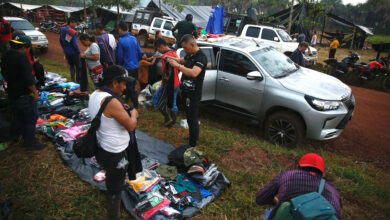Saravena, a Colombian rural area mired in conflict

By Jorge Gil Angel
Saravena, Colombia, Feb 24 (EFE).- Broken glass, destroyed buildings and makeshift barricades line the streets in Colombia’s Saravena, for weeks an epicenter of a bloody fighting between rival guerilla groups.
Tensions have been intensifying in the eastern Colombian rural area in the department of Arauca near the border with Venezuela, leaving 50,000 people in fear of what could happen to them day or night.
As soon as it gets dark, streets are left empty due to the night-curfew imposed weeks ago.
“The conflict in our territories is unfortunate because the war leaves us with only losses, significant human losses, the uprooting of the territory, some people have had to leave,” Adelis Contreras, community leader of the Charo Centro village, tells Efe.
The presence of guerillas of the National Liberation Army (ELN) and dissidents from the Revolutionary Armed Forces of Colombia (FARC) is also felt in the adjacent town of Puerto Narino, where graffiti drawings of the warring groups are seen on the walls.
“The conflict causes great trauma, (…) I am worried because there is no end in sight to this yet. As leaders we are at the mercy of this conflict because we have no one to take care of us; only God,” says Contreras, a member of the Territorial Agri-Food Farmers, made up of regional organizations.
Unlike other areas of Colombia where drug trafficking is the main trigger of violence, in Arauca there are few coca crops and social leaders there say the conflict is due to hydrocarbon production and old disputes with oil companies.
Between January 1 and February 21, some 99 people were killed in Arauca, 45 of which were in Saravena and more than 1,750 others were forced to flee their homes, according to figures from the country’s ministry of defense.
In addition, six human rights activists were killed between January 2020 and June last year, according to the We are Defenders program.
The high number of deaths caused fear among Saravena inhabitants, but what added fuel to the fire was the January 19 car bomb attack in the central area of the town, killing one person.
The attack was targeting the Hector Alirio Martinez building, which is the headquarters of dozens of social organizations in the region. Neighboring buildings also suffered extensive material damage.
That attack was ordered by the 28th Front of the FARC dissidents, led by Omar Pardo Galeano, also known as Antonio Medina.
“Antonio Medina, from the 28th Front, began to circulate threats (in leaflets) against the community, especially presidents of community action boards,” a Saravena official, Jose Luis Lasso, says.
The situation is too tense to the point that, by mid-February, the Ombudsman office received more than 200 complaints of threats, displacement and murders from victims who fear for their lives.
For Lorena Mendoza, a member of the Regional Student Youth Association, the aim is “to change all issues facing the youth” and therefore she believes it is necessary to guarantee them “the necessary conditions to higher education, and job opportunities.”
“We never want to leave Arauca, but if we have to, it’s because of a lack of opportunities. If we go to study in other departments, it’s because there is no public, free, quality university here where all young people can attend,” adds the young woman, hoping to have a more peaceful future. EFE
jga/smq/mp





